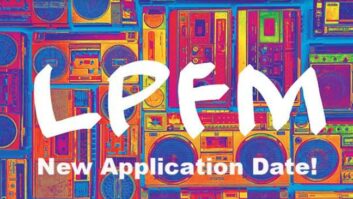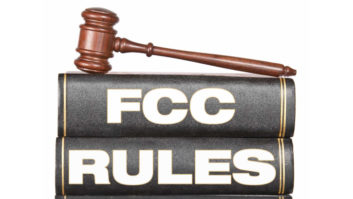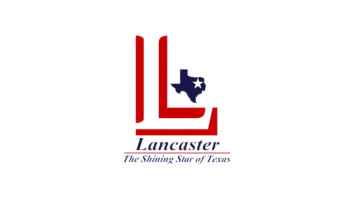Editor’s note: The window for filing applications for new LPFM stations has been pushed back. It will now run from Dec. 6 to Dec. 13. Learn more here.
Radio World is pleased to introduce a series of articles intended for readers who may be interested in applying for a low-power FM station license in the FCC’s upcoming window in November 2023.
The author is Sharon Scott, president and co-founder of ART FM, WXOX in Louisville, Ky. Sharon is the author of the new book “Low-Power FM for Dummies.”

A miracle moment is approaching for anyone who has ever dreamed of building a radio station to serve their local community.
On Nov. 1, the Federal Communications Commission will open an eight-day window for low-power FM applications. These small FM frequencies (100 watts at 100 feet height above average terrain) will be available to nonprofit organizations that hold no other broadcast interests. (In this series we’ll be writing for that readership, but be aware that tribes and certain government entities can also qualify; if you’re in one of those special categories be sure to check the rules to understand how the following information applies to you.)
So, don’t worry if you have no radio experience or aren’t affiliated with a nonprofit organization. There is still time to get up to speed … but you will have to get started right away!
The official LPFM information from the Federal Communications Commission can be found on the FCC website.
The steps for applying for an LPFM construction permit are as follows:
- Find a frequency
- Find or found a nonprofit
- Locate a tower site
- Conduct an engineering study (if necessary)
- Get an optional Letter of Assurance from the landlord
- Write an Educational Statement on how you will use the frequency
- Wait for the FCC to open the application window
- APPLY Nov. 1–8, 2023
Before getting your hopes up, make sure there is a frequency available in your area.
Due to the limitations of the FM dial, frequencies are harder to come by in urban areas than they are in rural landscapes.
REC Networks offers an interactive map that shows the potential locations for future LPFM stations. Start with a metro area and use the navigation arrows on the side of the map to move to more specific destinations.
Serious parties should contact an experienced broadcast engineer, ideally one with experience working with LPFMs. Careful human attention can tell you about the FM opportunities in your target area. Most provide free initial consultations.
The organizations Common Frequency, the Prometheus Radio Project and International Media Action are nonprofit organizations with broadcast engineers on staff who have helped hundreds of LPFM radio stations take to the airwaves since the FCC approved the LPFM service in 2000 and Congress passed the Local Community Radio Act in 2010. Also, REC Networks and Brown Broadcast are leaders in community radio engineering who are currently taking new clients but will be busting at the seams soon!
[Sign Up for Radio World’s SmartBrief Newsletter]
If you are not with a nonprofit group and would like to start one for the purpose of applying for an LPFM, you should do so immediately. Usually three board members are required, though sometimes only one. Each state is different; check on the website of your state’s secretary of state.
You may find an online form for filing nonprofit articles of incorporation. Otherwise you or your attorney will need to draft and file your articles as simply and as quickly as possible. Within a couple days of filing, the state should send you confirmation of your nonprofit status and you will then be eligible to apply for an LPFM license.
Note, LPFM applicants do NOT have to be 501(c)(3) tax-exempt organizations.
Nonprofit organizations that apply for LPFM licenses must qualify as “local” as defined by the FCC. In the top 50 markets, “local” means that either your headquarters or 75% of your board members’ homes must be within 10 miles of the proposed transmitter site. In the rest of the country the distance increases to 20 miles. REC Networks has created an online tool for determining Nielsen market status, find it here. (If you’re a tribe or a government entity planning a public safety service, check the rules for different parameters.)
If you have competition for your selected frequency, the FCC will place you in a “mutually exclusive” or MX group. If one application were to be granted, the others could not be without causing interference. If these mutually exclusive applicants cannot work out a time-sharing situation, the commission will choose among them. It uses priority points to determine the winner of each MX group. These points are granted for:
- Established organizational community presence for at least 2 years
- Pledge to create local programming at least 8 hours per week.
- Pledge to have a main studio staffed and publicly accessible at least 20 hours per week.
- Local program origination and local main studio (both 2&3 above)
- Diversity of ownership, organization owns no other broadcast entities
- Tribal applicants on tribal lands
While rural applicants with plenty of airspace may not need to consider these priority points, they will be critical to urban organizations.
After receiving a construction permit, organizations will have three years to build their station and get their signal on the air. They will also be able to transfer the license to another nonprofit organization that has the proper qualifications.
It has been a full decade since the FCC provided an LPFM opportunity. With an increasingly crowed band, it may never happen again. There is not much time to get the word out between now and Nov. 1 but it is easy to get prepared. You can learn more in this series of Radio World articles and on the website.
Also note that the 2023 Grassroots Radio Conference will take place Oct. 19–22. Hosted by WTSQ(LP) in Charleston, W.Va., this year’s conference will provide the opportunity to connect with community radio experts while attending LPFM-intensive sessions.
Nonprofit organizations interested in LPFM licenses should not wait for the conference, however, to prepare for the FCC application window. It is not difficult to apply for an LPFM construction permit but it is imperative that you do everything correctly or your application will be dismissed — which is why I recommend that you immediately contact an experienced broadcast engineer or an LPFM advocacy organization.
Stay tuned! In subsequent articles we will walk through the steps of obtaining an LPFM license such as securing a transmission site, why a Letter of Assurance is a good idea, and drafting an Educational Statement for your proposal.
Nearly 2,000 community organizations are on the airwaves with LPFM stations. Soon yours can be too. Seize the opportunity. Make this November your miracle moment.
For questions or suggestions email the author at gm@artxfm.com.
[Read more about the promise and challenges of low-power broadcasting in “An LPFM Window This Fall Presents Opportunities”]






